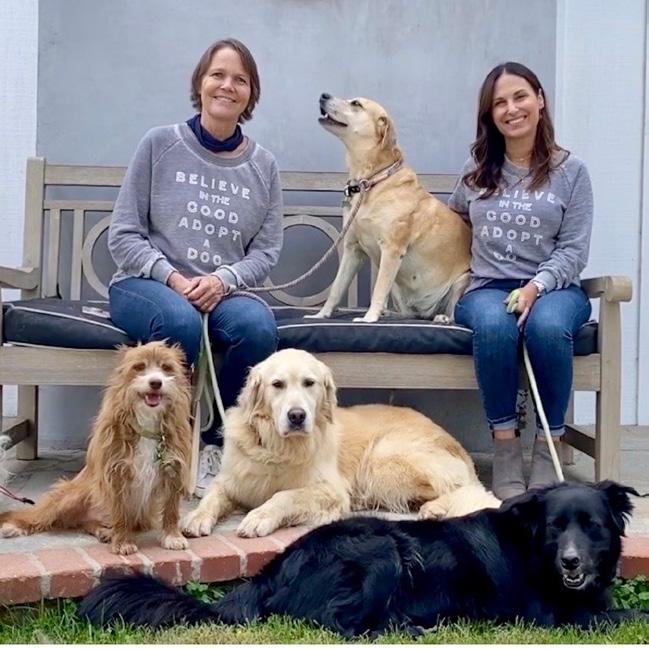
15 minute read
GIVING BACK
by Pam Maley
Gentle Souls and Big Hearts
— DR. SEUSS
In recent years, as a nation, we have become increasingly aware of innocent animals in trouble: dogs threatened with euthanization, horses being slaughtered. As we have awakened to this tragedy, generous, caring people have stepped up to protect these voiceless creatures that depend on the humans that they trust. We highlight here a few of the pioneers in this effort, and as animal lovers, we salute them.
On January 20, 2021, for the first time ever, a rescue dog moved into the White House. Major Biden was one of a litter of sick puppies that had arrived at the Delaware Humane Society in Wilmington. Joe and Jill Biden volunteered to foster one of them and provide the care he needed to get well, and in the process, the Bidens became arguably the most famous ‘Foster Fail,’ a term you'll read about in our first segment.
SPREADING JOY
Thrive Animal Rescue
CeCe Bloum had retired from a successful career as a trainer of “A” circuit riders and horses (during which she inspired The Horse Show Mom’s Survival Guide, by Susan S. Daniels), because she felt that her three children needed her full attention. By 2014, they had all grown into young adults, and it seemed a good time for a new adventure.
When her friend Ron Spogli asked her what she’d like to do, the answer came without a moment’s hesitation, “A dog rescue!” It turns out that Ron’s wife, Georgia, had the same dream, and immediately, a partnership was formed. They recruited dog-loving friends from the equestrian world, put together a board of directors, applied for 501c3 status, and began the journey that continues to this day.
For this story, Horse & Style interviewed CeCe, Susie Saladino, another of the original founders, and Nicole Velazquez, the Executive Director. Their delight in the growth and success of Thrive Animal Rescue, and their love for what they’re doing, was palpable throughout the conversation.
CeCe and her husband Steve dedicated a large grassy fenced area on their Newmarket Farm to Thrive, as a place where the dogs could come to roam free after leaving the shelter, a ride dubbed by Susie the ‘Freedom Ride.’ Board members and volunteers would comb the most overcrowded and underfunded shelters to find dogs facing euthanization that would be safe around children, horses, and other dogs; and load them up for the Freedom Ride.
But as Thrive has become better known in the community, they are getting more and more calls for help. “The calls come from all over,” says CeCe. “Thrive has developed really good relationships with the Humane Societies, and they will call if they have a dog that fits the profile. And then there are the individual calls about dogs whose owners succumbed to COVID-19, dogs orphaned or displaced by the wildfires, dogs pushed out because their owners had to downsize … We’ve seen people having to make hard decisions.” The day after our interview, they were going to answer a call to pick up two dogs whose owner had passed away.
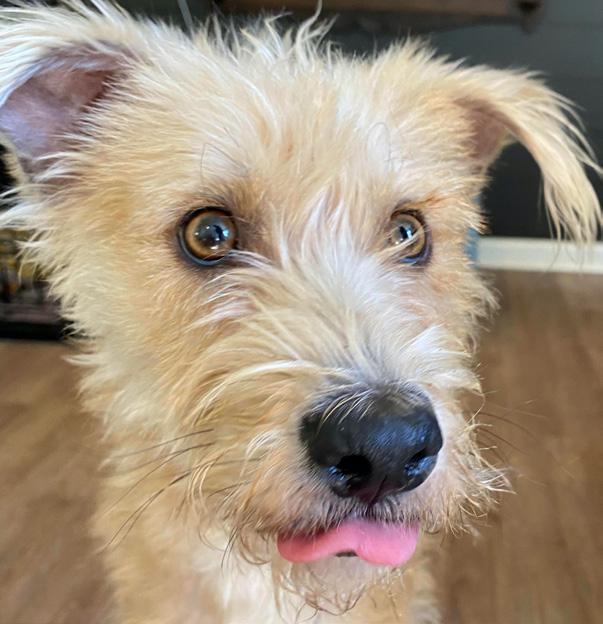
All photos courtesy of Thrive Animal Rescue


Thrive has seen phenomenal growth since 2014, in community recognition and numbers of successful adoptions, as well as in the physical size of the facility. Still on the grounds at Newmarket Farm, it now has 12 more big fenced turnout yards, a meet and greet area where a dog and a would-be adopter can connect, a vet office – yes, there’s a vet on-site now, and a puppy nursery.
The Freedom Ride always ends at the farm. There, the dogs will be evaluated as their personality traits emerge, and all medical needs will be taken care of. They will be walked and crate-trained, and cared for. Some will then go to foster homes (about ¼ of them), and the rest will remain on the farm to await adoption.
As unique needs have come to the attention of the Thrive staff, new programs have been launched to meet them. There’s the Forever Foster program for senior dogs. Seniors are pulled from shelters and brought to the farm, where medical needs are assessed and tended to. They can then remain on the farm (right now there are 12), or if they go to a foster family, Thrive will cover their medical expenses, which can be extensive and often a deterrent to adoption. They told us about a senior, Hugh Hefner, who recently died after spending two years in the program at the farm, and obviously had found a place in their hearts; and a new senior named Molly who had just arrived because her owner had died of COVID-19. So the circle goes around.
The puppy nursery was created because they take pregnant dogs or dogs with litters, and the pups can stay in the nursery to get a good start on life before they go up for adoption. They have also welcomed ‘Momma Dogs’ from Mexico, part of the huge street dog population that is a well-known problem there. In Mexico City alone, authorities report that they capture and kill an estimated 20,000 dogs per month. To help address this tragedy, in addition to taking in Momma Dogs, Thrive is also helping to spay and neuter the street dog population.
The new meet-and-greet area was born of their determination to find just the right match between dogs and their adopters, and a behaviorist works in this niche at the farm to help achieve a successful pairing. “We’re very picky about our adopters!” they all agreed. Susie manages their social media presence. “People really do pay attention to the website; they’re familiar with our adoptable dogs,” she tells us. “The internet has been very good for dog adoption. When we’re out and about in town, people will stop us and ask about the dogs, or about a certain one that they’ve been following.”
Thrive puts a great deal of effort into matching a dog with a foster family, just as they do with adopters. An adoptable dog’s stay with a foster family (or at the farm, for that matter) is usually somewhere between two weeks and a month. But because of the care that is taken to choose just the right dog, the foster family sometimes finds that they can’t bring themselves to give the dog up, giving rise to another staff-generated term: ‘Foster Fails.’ Every foster family sets out determined not to be a Foster Fail, but sometimes it just happens; love takes over. The most famous Foster Fail, as mentioned in the introduction, is now living at The White House!
Some of their fund-raising and adoption events have had to be curtailed due to the pandemic, but the equestrian community continues to offer their support and donations. And though the adoption events at horse shows have taken on a different look, with social distancing and safety measures, they have continued. “Horse people are the best adopters!” Nicole said emphatically. It seems that it is a rare occurrence for a dog to return to Newmarket after one of these events. They almost always go to a new forever home.
Nicole’s takeaway, she told us, “Is that it has been really heartwarming to see the people in the dog and horse community step up with their support, so that we can help people through these troubled times. After adopting, the new owners stay in touch, send pictures even years afterward, and express their gratitude.”
Clearly, this dedicated staff has not only created a remarkable organization that has offered new life to scores of dogs, they have created a phenomenon that brings happiness to everyone involved in the process. In addition to giving back, they are spreading joy!
To learn more about Thrive, or to make a donation, visit thriveanimalrescue.com
THE POWER OF ONE:
Georgina Bloomberg

Georgina Bloomberg and Rocky; photo © Geoffrey Tischman
Often thought of as an aspirational ideal, the power of one is alive and well in the person of Georgina Bloomberg. After adopting a dog from a rescue in Miami, she saw a need and set about filling it.
High-kill shelters are a huge problem, particularly in the Southern states. They are usually government-run, with little space and meager funding. By law they can’t refuse to take a dog, so in order to make room for new ones, some of the ones that are already there are euthanized. Sadly, the average length of a dog’s life in one of these shelters is about two weeks; the need is urgent!
Bloomberg’s show jumping career takes her to destinations all over the world, but her primary residences are in New York and Florida, and that set the parameters for her efforts. She realized that rescues have no problem pulling dogs from the pound and finding places for them; the problem is transporting them. With her large network of friends and colleagues in the horse world, who frequently travel between New York and Florida, she knew that she could help get dogs north from the kill-shelters in Florida to rescues in New York, where they would have a better chance of finding a home.

Georgina Bloomberg and Manhattan; photo © Jump Media
Three groups in New York partner with her: Animal Haven in New York City, SPCA of Westchester (New York), and Adopt-a-Dog in Armonk, New York. She began putting out feelers, and if someone was headed north on a private plane, or in a van, private or commercial, she would ask them to transport some rescues. Even her boyfriend has transported dogs for her.
The woman that runs the rescue where she adopted has been a big help to Bloomberg. “She knows dogs well, and can help select ones that will be good candidates for adoption. Being selective and leaving some dogs behind may sound like a bad thing, but it’s better to choose the right dog than to waste a foster opportunity on one that has little chance of success,” Bloomberg explains.
She also knows what type of dog her rescues are seeking. For example, in New York City, small dogs are preferred because of limited living spaces, while in Westchester, where spaces are larger and houses have more property around them, large dogs are popular. Rescue dogs often need veterinary care, rehab, or surgery, and the rescues take care of that. But Bloomberg is quick to point out, “Shelters often get healthy litters of puppies, and young thriving dogs. While behavioral issues develop the longer they stay in the shelters, for the most part, once a dog realizes that they are ‘out of jail,’ they do a quick turnaround.”
The pandemic, she tells us, has given adoption a lot of exposure, and in that way, it has been good. When the country went into lockdown in March, the numbers of foster volunteers skyrocketed, as did requests for adoptees. Post-pandemic, that might slow down, but we all join Bloomberg in the hope that the interest in adopting will continue.
On the other hand, there has been an increase in the number of people who are facing poverty, eviction, or illness, who are forced to make the heart-wrenching decision to give up a beloved dog. Bloomberg hopes to create temporary sanctuaries that can keep a dog while the owners get back on their feet. She has begun working with ACC (Animal Control Centers) in New York to make this a reality.
There are times when an owner is forced to give up a dog because it needs medical care or surgery that the owner simply can’t afford. “People are quick to judge owners in that position, but it’s very real, and I hope to include in this project an organization that can provide owners the help they need.”
Right now, the owner has to face the decision to give up their dog permanently. “I want to change that. My goal is to get them fostered or into a temporary place, so that when the owners are able, they can take their dog home again. That’s what I feel really passionate about.”
THE BUGLER’S CALL
Mid-Atlantic Horse Rescue
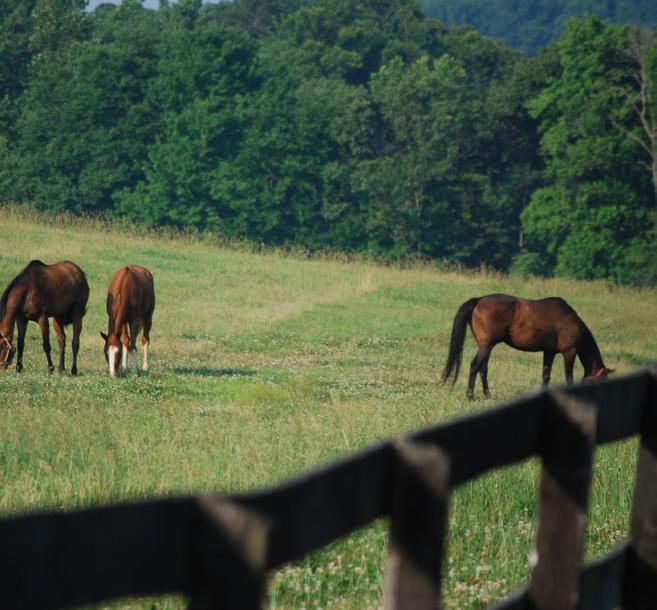
About 20 years ago, friends Bev Strauss and Ginny Suarez (now Cole) were trainers at Delaware Park Race Track. Suarez was also running a successful dog rescue that she had started, called Paws for Life, and in that context, they talked a lot about the fate of thoroughbreds after their racing careers ended. They realized that many of the horses were going to auction, and they were well aware of the kill-trucks awaiting them.
In all equestrian disciplines, the horses are the centerpiece of the sport. Horse Racing is no different. Every day, thousands of thoroughbreds answer the bugler’s call. But the working life of a racehorse is short; and the sad reality of the industry is that a lot of healthy, young, sound thoroughbreds never get a second chance.
Many years ago, the slaughter of horses was made illegal in the United States, but unscrupulous agents have managed to work around that by loading their trucks with no-bid or cheap horses at the auctions, and transporting them to Mexico to sell to the slaughter-houses there.
In 2002, Strauss and Suarez decided to take the leap, and set about forming an organization that they would call Mid-Atlantic Horse Rescue. They attached it to Paws for Life to get it started. By 2011, though, they had to split, but for a happy reason: both had gotten too big.
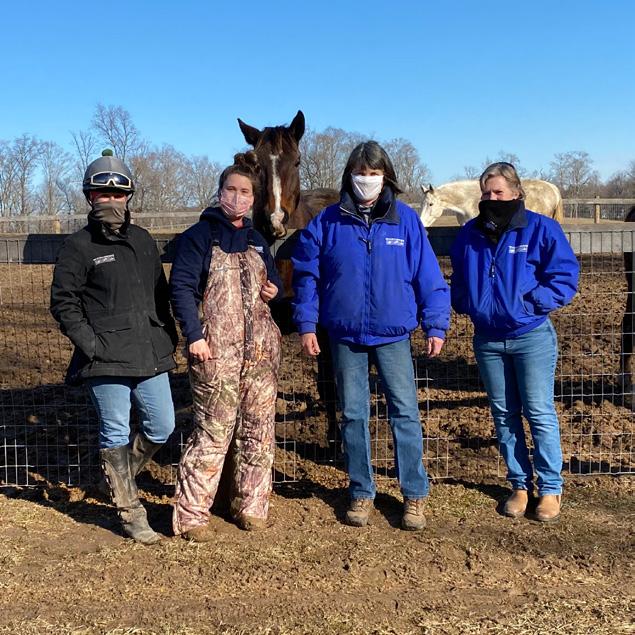
MAHR Team Members
“At the beginning, all of our rescues came from the New Holland Livestock Auction near us, in New Holland, Pennsylvania,” says Strauss. She and Cole would go to the auctions and keep a close eye on the kill-pens (horses bought by kill buyers) to find and buy horses (they only buy thoroughbreds) that looked promising for a new career. “Over the years, though, the racing industry has become aware of the need for aftercare, so we can now work directly with many of the racetracks as well. Our main contact is with Delaware Park – we handle the aftercare there – but we also work with the Maryland tracks, Penn National, and Mountaineer in West Virginia. And still . . . many of our horses come from the kill-pens at the auctions.”
The Thoroughbred Aftercare Alliance (TAA), begun in 2012 and funded by the racing industry, was a real game-changer, Strauss says. Mid-Atlantic was one of the first rescues to receive accreditation from TAA, and they regularly receive generous grants from them, and from other national organizations like the ASPCA.
Their first grant came from Thoroughbred Charities of America, when “in 2002, Ginny and I went with our hats in hand to ask for our very first grant as a newly formed rescue, with just three horses and a rented field.” How they have grown!
They now have a beautiful farm in Eastern Maryland, 158 acres, with 80 acres fenced and a full-time staff member living on the grounds. They have a barn and several small paddocks, because horses recently in training need some let-down time. “They lose weight at first, they look thin, their muscles sag. At the track, they’re in the stall 24 hours a day, except for workouts and races. We give them high-concentrate feed, and they begin putting on weight and learning ‘to be horses again.’ Sometimes it takes a while for them to get used to being turned out in a big field with other horses. We like for them to be out 24/7, if possible. We find that they are happier, and it saves on our expenses.”
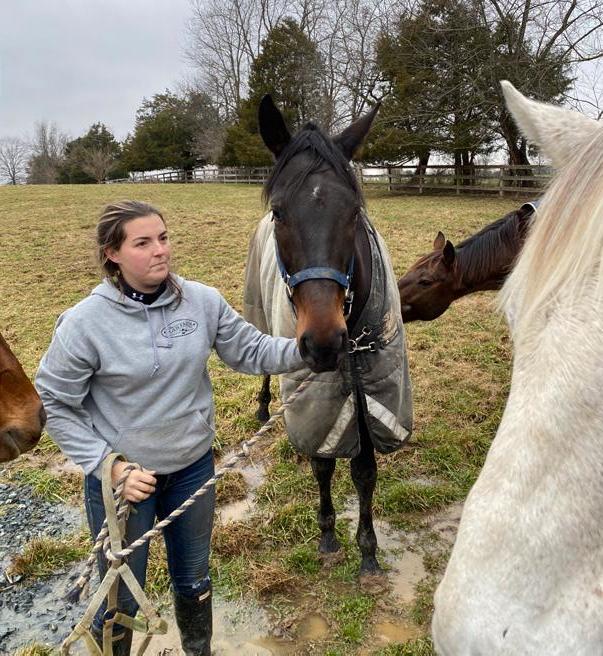
Morgan Hayden with Whiskey Sour and friends
Right now at the main farm, they’re at capacity with 45 horses. They have also established four satellite farms: two do rehab for horses that need time off, stall rest, or postsurgical care; one is a boot camp for those that need a bit of attitude adjustment; and the third is a farm in South Carolina that has only horses that are ready for adoption. Most adoptions, though, are done at the main farm.
Once on the farm, the first step is quarantine for a minimum of 30 days. During this time, they are evaluated as to general health, soundness and rideability. The latter depends a lot on the skill of the would-be adopter. Some are more challenging to ride than others, which makes finding the right adoption partner important.

The horses are ridden to assess each one according to energy level and movement. Higher energy horses are pointed toward jumping or eventing; those with a smooth, long gait are groomed for the hunter ring; some are just for trail riding; some for dressage or foxhunting; then there are those that are only able to be pasture pets. Their adoption fee is $1.00, with the agreement that they can come back to Mid-Atlantic if need be.
“Would-be adopters fill out a simple application. When people reach out, I try to determine what they’re looking for, what their goals are; did a horse on the website catch their eye? We prefer potential adopters come to ride,” Strauss says, “and I’m always there. If they’re interested in a horse that doesn’t seem right for them, we try to guide them to a good match. Safety and suitability are the overriding goals. We won’t adopt a horse to a person if the match seems wrong.”
Since its inception, Mid-Atlantic has rescued and found homes for over 2,000 horses. They now have lots of individual supporters and donors, in addition to grants from national agencies. Their adopters, says Strauss, are their best advertising. There is no shortage of candidates for rescue. “We get calls from farms, and from people who have gotten horses elsewhere that are not working out. Horses from our partner tracks and in the kill-pens are our first priority. We will always take any horse back that came through our program. We wish that we could help every horse that needs us, but we just can’t rescue all of them.” Even through the pandemic, adoptions and donations have held strong, despite worries to the contrary.
“We think of our adopters as partners. We stand behind our horses always, we guarantee them, and we’re always there to help.”
To learn more about Mid-Atlantic Horse Rescue, or to make a donation, visit midatlantichorserescue.org.










